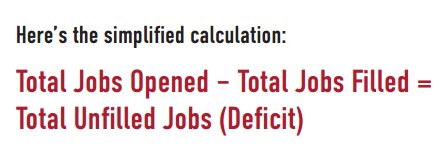 Every company has that list of jobs that goes unfilled every month. You know the ones. It’s those jobs that have been “on hold” longer than you care to admit, or sit in your recruiter’s list with little to no activity. Whatever the reason, this rolling list of unfilled positions has a snowballing effect on your company, and unlike the U.S. fiscal deficit, there is something that you can do to reverse this talent deficit.
Every company has that list of jobs that goes unfilled every month. You know the ones. It’s those jobs that have been “on hold” longer than you care to admit, or sit in your recruiter’s list with little to no activity. Whatever the reason, this rolling list of unfilled positions has a snowballing effect on your company, and unlike the U.S. fiscal deficit, there is something that you can do to reverse this talent deficit.
It’s not a wiki-certified term, but we like to think the rolling talent deficit is a fitting name. These are jobs that due to lack of recruiting resources, unavailability of talent, or financial constraints, remain open for long periods of time creating a black hole for of recruiting costs.
For many organizations, the talent deficit snuck up on them without warning. Between recruiting at pre-recession levels, with little to no increase in resources, to the increased use of temporary labor, or the aging workforce population, the number of open and new positions continues to soar.
How to Diagnose a Talent Deficit
To see the full impact that a talent deficit has on your organization’s ability to attract talent now and into the future, allows us to demonstrate how exactly it works. Let’s say you are responsible for hiring IT talent into your organization. Up until recently, there wasn’t a high demand for tech talent, however with the recent growth spurt, let’s say an expansion into a new market, the boom hits.
Like a number of industries, the tech talent market is one where the labor demand exceeds the number of available candidates. You know this, but your head of talent acquisition doesn’t. So, when you get the request to hire 10 new IT security engineers, naturally you panic. Thirty days goes by and not for lack of trying, your recruiting team comes up dry. And, to be fair, let’s say scheduling conflicts between key hiring managers impacted the ability for your top candidates to be seen, and thus they’ve fallen out of the pipeline.
It is now months later, and only a quarter of the IT security engineer positions are filled. On top of that, two months ago you got a new request for three software engineers. As you can see, for every painful step forward, the IT recruiting team feels like they are moving backwards.
The good news is that you can do something to reverse this downward and downright dangerous trend. Start by using this simple formula to diagnose your rolling talent deficit. Once you understand the gravity of your deficit, there are a number of actions you can take to course correct it.
The Impact on Recruiting & Retention
Beyond employee morale taking a nose dive, let’s look at some of the bigger repercussions the rolling talent deficit has on the organization. In short, it can negatively impact your employment brand. Candidates see those same positions pop up on the job boards for weeks or months. They begin to wonder why the job hasn't been filled and consequently, are reluctant to apply.
Next, the talent deficit can result from a number of internal and external factors. Let’s say unlike our IT staffing example, your labor market is wide open for the taking, but your internal hiring processes leave room for improvement. When candidates end up in long submittal and interview cycles without hearing anything, it’s a bad start to an employment relationship. This can ultimately lose the candidate and extend the lifeline of an open position.
Finally, regardless of the hiring process or landscape, operating in the recruiting red can lead to desperation. Corners are cut and sometimes the quality of a candidate is sacrificed. Turnover goes up and now you’ve further compounded the problem with even more positions to fill and increasing questions about your company.
If left unchecked, the impact of a talent deficit can be felt for years to come. Focusing on short-term recruiting issues such as the number of recruiters or specific recruiting processes and tools will not address the bigger issue. Looking at and taking action to correct a rolling talent deficit is a long-term recruiting strategy that is sure to pay dividends.
About the Author: This blog was written by Alexandra Calukovic-Deck, aka the Marketing Guru, a digitally-driven marketer. Claims to fame include the longest possible last name ever, certifications in Strategic & Inbound Marketing practices, and lover of all things Philadelphia.




